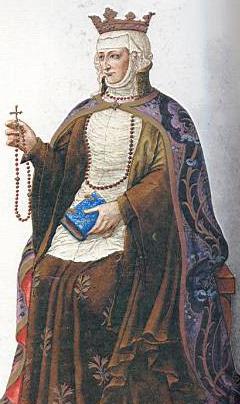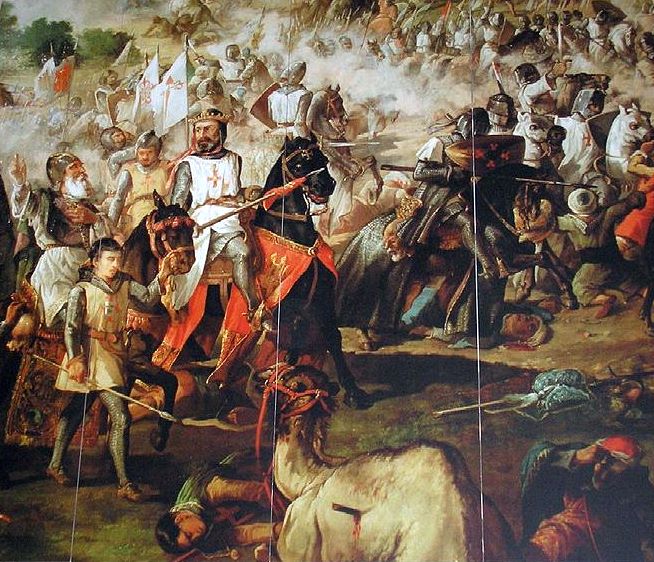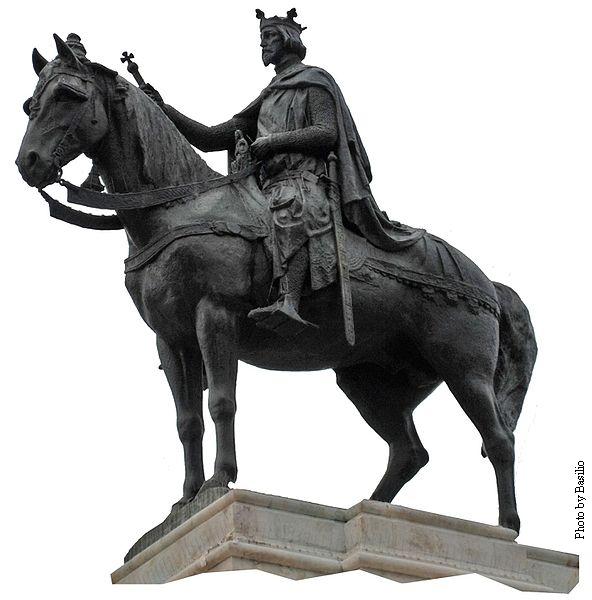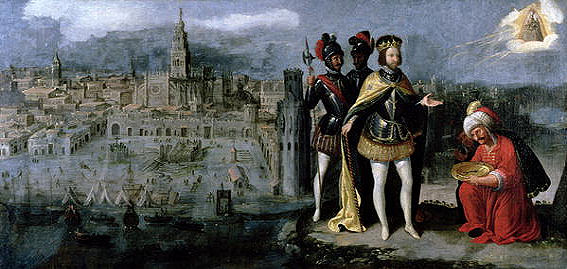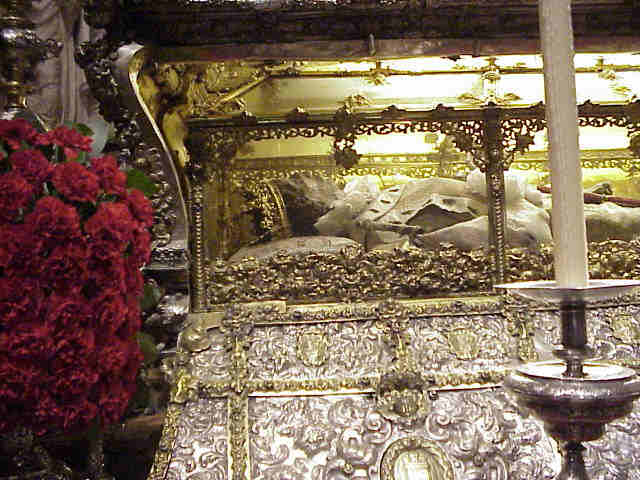Saint Ferdinand III of Castile - Most Valiant King
nobility.org
Saint Ferdinand III of Castile. Painted by Spanish School.
In 1217 Ferdinand became King of Castile, which crown his mother renounced in his favor, and in 1230 he succeeded to the crown of Leon, though not without civil strife, since many were opposed to the union of the two kingdoms. He took as his counselors the wisest men in the State, saw to the strict administration of justice, and took the greatest care not to overburden his subjects with taxation, fearing, as he said, the curse of one poor woman more than a whole army of Saracens. Following his mother’s advice, Ferdinand, in 1219, married Beatrice, the daughter of Philip of Swabia, King of Germany, one of the most virtuous princesses of her time. God blessed this union with seven children: six princes and one princess. The highest aims of Ferdinand’s life were the propagation of the Faith and the liberation of Spain from the Saracen yoke. Hence his continual wars against the Saracens. He took from them vast territories, Granada and Alicante alone remaining in their power at the time of his death. In the most important towns he founded bishoprics, reestablished Catholic worship everywhere, built churches, founded monasteries, and endowed hospitals. The greatest joys of his life were the conquests of Cordoba (1236) and Seville (1248). He turned the great mosques of these places into cathedrals, dedicating them to the Blessed Virgin. He watched over the conduct of his soldiers, confiding more in their virtue than in their valor, fasted strictly himself, wore a rough hairshirt, and often spent his nights in prayer, especially before battles. Amid the tumult of the camp he lived like a religious in the cloister. The glory of the Church and the happiness of his people were the two guiding motives of his life. He founded the University of Salamanca, the Athens of Spain. Ferdinand was buried in the great cathedral of Seville before the image of the Blessed Virgin, clothed, at his own request, in the habit of the Third Order of St. Francis. His body, it is said, remains incorrupt. Many miracles took place at his tomb, and Clement X canonized him in 1671. His feast is kept by the Minorites on the 30th of May.
FERDINAND HECKMANN (Catholic Encyclopedia)
_______________________________________
Saint Ferdinand III of Castile
by Jeremias WellsKing Alfonso VIII of Castile, the great leader of Las Navas de Tolosa, left two daughters who became queen mothers of two young kings, both of whom developed into illustrious warriors, crusaders, and saints. Because Alfonso’s two sons died in their youth, one from illness in 1211 and the other from a tragic accident in 1217, their sister, Berenguela, rose to the throne of Castile. However, realizing that it was improper for a woman to occupy the throne in this most chivalrous state, she renounced her kingdom to her first born son, Ferdinand III, then only eighteen.
Blanche, the second daughter, married King Louis VIII of France who, after an exhausting campaign against the remnant of the Albigensian rebellion, died in 1226. Since Louis, his oldest boy, was only twelve at the time, the Queen acted as regent while the young King slowly assumed the control of government during the next two decades. In a remarkable display of piety, both Kings saw the necessity of renouncing any earthly comfort to further the interests of Christendom and their own realms.
Youth of Ferdinand of Castile
Because the future King’s parents were related within the forbidden degree of consanguinity — they were second cousins — Pope Innocent III insisted they separate and, as a result, young Ferdinand was brought up at the court of his grandfather. The serenity of the boy’s life was shattered when a terrible malady overtook him at the age of ten. Consumed by a high fever and horrible restlessness, the devout lad could not eat, sleep, or take any rest. When the poor child developed large repulsive sores which caused unrelieved pain, death seemed imminent.
Dona Berenguela took him to a chapel of Our Lady where she prostrated herself on the cold tile floor in front of the main altar and prayed throughout the night. When her servants returned the following morning, they found the boy sleeping soundly. As a consequence of the miraculous cure, San Fernando from then on dedicated himself to the service of the Blessed Virgin.
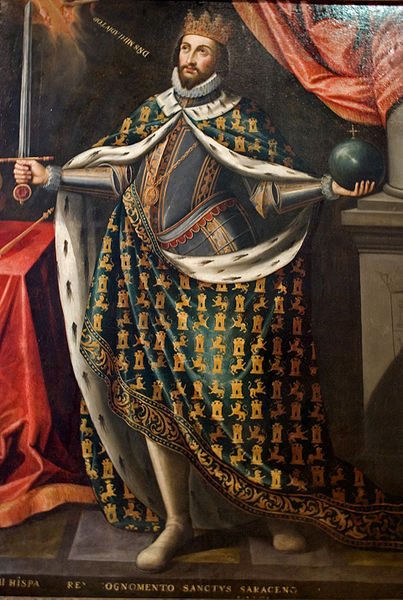
In 1214, Alfonso VIII died, leaving the Kingdom of Castile to Berenguela’s adolescent brother Enrique (Henry) who, in turn, was entrusted to the regent Count Alvaro Nunez de Lara, a man noted for his ambition and avarice. More misery fell upon the family when Fernando’s father, King Alfonso IX, ordered his son — now fifteen — to be sent to his corrupt court in the Kingdom of Leon.(1)
Since the upright young man could find no alternative to his obligation of obeying his father’s command, he told his heartbroken mother, “Christ redeemed us not in the sweet arms of His mother but on the hard arms of the Cross, and His knight will not serve Him in any other way,” and went off.
For the first time in his life, he witnessed the degrading spectacle of immorality and found the things that he saw and heard deeply repulsive. What was more painful was that his father was one of the worst sinners. He realized that he must fight like a hero or be dragged into the mud like so many others, losing in the process an unrecoverable treasure: his innocence. During this period Fernando practiced the handling of weapons for long hours and rode great distances in cold, rainy weather to accustom his body to hardship.
Meanwhile, Count Alvaro was terrorizing Castile with cruelty and injustice. His ambitious plans were suddenly unraveled when young Enrique, while playing with some companions, was struck on the head by a roof tile and died a few days later. After cleverly escaping from his father’s clutches, the eighteen-year-old heir to the Castilian throne rode south to give support to his mother. However, she quickly yielded her rights to Fernando, who was proclaimed King of Castile.
Once Alfonso realized he had been tricked, he, with encouragement from Alvaro, invaded Castile in order to drive his son from the throne. Fernando, now faced with a dilemma of either taking up the sword against his father, which greatly troubled his sensitive soul, or abandoning his responsibility to his subjects, brought an army into the field opposite his father’s.
That night he sent his wise counselor Archbishop Roderigo Ximenez de la Rada along with other bishops to plead with the Leonese King to act honorably and with justice. Realizing that even his own followers sympathized with the young saint, Alfonso agreed not to attack providing Fernando pay a large sum of money. When the bishops returned to Fernando’s tent that night to report on the successful negotiations, they found the young King in his private chapel praying with his arms in the form of a cross and with the back of his white tunic stained with blood. He had applied the discipline for the sins of his father.
Although the two were reconciled as Kings, they never entered into a father and son relationship. Alfonso finished out his days fighting against the Moors with a contingent of Castilian troops. Shortly after the conclusion of peace, Berenguela arranged a marriage for Fernando with Beatrice of Swabia, a close relative of the ruling Hohenstaufen family in Germany and Sicily.
Fernando renews the Reconquest
In 1224, with his internal political affairs resolved, the youthful Crusader turned his attention to the Reconquest, a military campaign that with a few short intervals occupied him for the rest of his life. Quesada, the first town to fall, was typical of the many that followed. The Castilians placed cloth-muffled ladders against the walls just before daylight. Fernando raced up a ladder, jumped on the wall first, and struck down an approaching guard with a firm gashing blow to his head. The other knights were just seconds behind. Shouting, “Santiago and Castile,” the Crusaders threw themselves into the fight to protect the life of their valiant King, who always seemed to be ahead of them. Slashing and cutting, they gained control of the wall and towers and opened the gates, allowing their army to rush in and capture the streets and squares. The first rays of the sun saw the town in Christian hands.
On the highest tower, Fernando, covered with Moslem blood from head to toe, planted the Cross and, gazing at it lovingly, prayed:
“Knowest that I do not seek my glory but thine; not the greatest of perishable kingdoms, but the kingship of Christ on earth.”
Throughout the next six years, Fernando raided central Andalusia, capturing most of the small towns, ravaging the countryside, collecting much booty. Only the three large, walled cities of Cordoba, Seville, and Jaen avoided capture because of their massive fortifications and large garrisons.
King Alfonso of Leon died in 1230. As Fernando rode north to claim his father’s kingdom, he received shocking news. Although the mercurial King had earlier chosen his son as his heir in a formal session before Parliament with the Pope’s approval, he changed his mind and left Leon to two daughters from a previous marriage which was also annulled. Alfonso had reached from beyond the grave to injure his son one more time.
Both the mother of the princesses, Dona Teresa,(2) who had retired to a convent many years before, and Dona Berenguela traveled to Leon to prevent a bloody dynastic war since several ambitious noblemen saw an opportunity for riches and political gain. In a series of
calm, recollected discussions, those two magnificent ladies realized that the only just and appropriate solution was for the two royal daughters to abdicate. Although it required a great sacrifice on their part, they followed their mother’s wise advice and were rewarded with a generous pension from Fernando. As the monarch rode back to the battlefield, he was now backed by the resources of the new, powerful Kingdom of Castile and Leon which, from that point on, remained unified.
During the 1230’s, the Christian rulers of Spain maintained continual pressure against the Mohammedans by pushing south along a broad front. West of the Gaudiana, the military orders of Calatrava and Santiago helped Portugal extend their southern boundaries.
Just to the east of the river, Fernando’s brother, Alfonso de Molina, led a marauding army past Cordoba and Seville to Jerez where he won a stunning victory over superior numbers. Santiago (Saint James) was seen, even by the Moslems, on a white horse and with
his sword drawn, leading a legion of knights.
On the eastern front, another successful crusading King of the first rank, Jaime (James) I of Aragon, who had previously captured the island of Majorca, forced the capitulation of Valencia, which in essence completed the Aragonese Reconquest.
Cordoba
Cordoba reached the height of its material splendor under the Omayyad Caliphate of Abdu-r-Rahman III (d. 961) and the ruthless dictator Al-Mansur (d. 1002) who, after he razed the great church of Santiago de Compostela, forced Christian captives to carry the huge church bells back to his capital city. Thereafter, the opulent city suffered something of a decline in wealth and culture because of the repeated conquests of the fundamentalist Berbers from North Africa (the Almoravides and Almohades). Nevertheless, Cordoba remained a formidable target for any Christian attack.
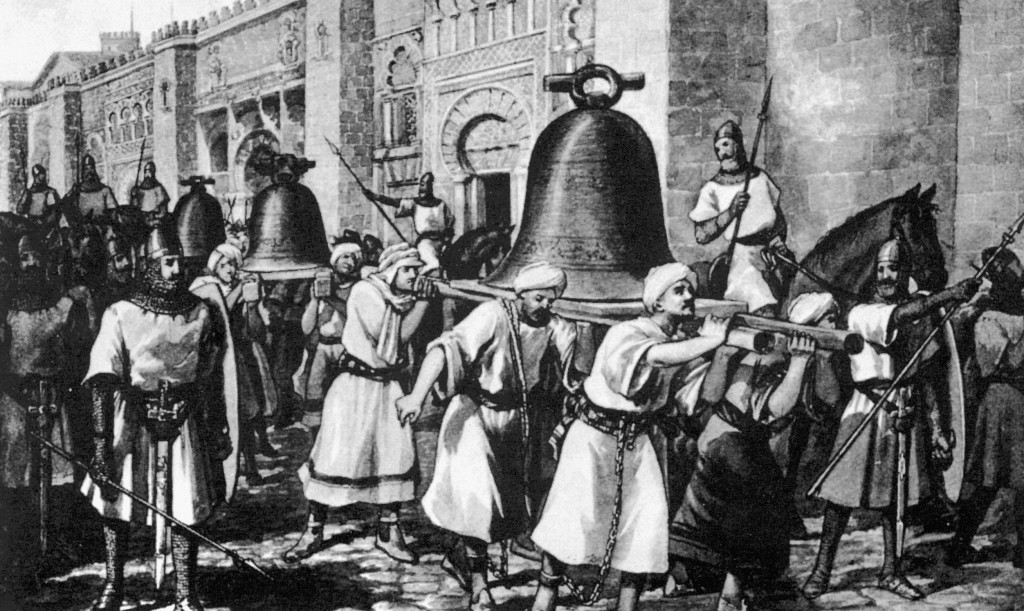
When
Al-Mamsur conquered Santiago de Compostela and razed its church, he
forced the Catholics to carry the large church bells to Cordoba, his
capital. Years later, St. Ferdinand re-conquered Cordoba and obliged the
Moslems to return the same bells to Compostella.
Seville
In 1246 Fernando besieged Jaen once again, having already failed three times. When it became evident that this time the fortified
city would fall, the King of Granada, its master, knowing his own kingdom would be next, decided to cut his losses. He agreed to surrender Jaen and become Fernando’s vassal if the latter would allow him to keep the Kingdom of Granada, which included the port cities of Malaga and Almeria. Fernando approved and Granada became a vassal state of Castile, a status that it retained until 1492.
The crusading Castilian could now turn his attention to Seville, the greatest city in Western Europe at the time. Seville was situated on the west or left bank of the Gaudalquivir River sixty miles from the Atlantic Ocean and was connected with its suburb, Triana, on the opposite bank by a bridge of boats. The river downstream, actually an estuary, was navigable. Fernando’s first task was to break the ring of walled towns and fortresses within a twenty mile radius that guarded the approaches to the city. The residents of those towns that capitulated could remain unmolested in their homes but had to turn over the citadels and fortifications to the Castilians. The towns that resisted were captured and the inhabitants killed.
Since the Gualalquivir was navigable up to Seville, naval vessels played an integral part in the investment of the city in order to cut off
communications and supply routes. The Spanish Admiral Ramon Boniface assembled a fleet in the bay of Biscay, brought it around the peninsula, and after several engagements gained control of the river. His most spectacular success came in May 1248 when two large
galleys rammed the bridge of boats with such force that the chains which held the boats in place snapped, allowing the current to carry the two halves harmlessly to shore.
The siege reached a critical stage during the summer when famine, disease, and terrible heat brought unbearable suffering to both sides. The moral elements of fortitude and determination gained in priority, which gave the advantage to the Christians because of their battle-hardened warriors, a large number of whom were the devoted monks of the military religious orders. The Moslems capitulated in November and after lengthy negotiations agreed to evacuate the city along with its dependent villages. Hundreds of thousands of Mohammedans under Christian escort retired to Granada or were transported to North Africa.
The privations and austerities of camp life and the rigors of his spiritual life had destroyed San Fernando’s health, and he died shortly after in 1252. The great Crusader, whose body is whole and incorrupt to this day, was revered as a saint long before his canonization in 1671.
by Jeremias Wells, Crusade Magazine July-August 2001

